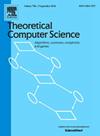On layered area-proportional rectangle contact representations
IF 0.9
4区 计算机科学
Q3 COMPUTER SCIENCE, THEORY & METHODS
引用次数: 0
Abstract
Semantic word clouds visualize the semantic relatedness between the words of a text by placing pairs of related words close to each other. Formally, the problem of drawing semantic word clouds corresponds to drawing a rectangle contact representation of a graph whose vertices correlate to the words to be displayed and whose edges indicate that two words are semantically related. The goal is to maximize the number of realized contacts while avoiding any false adjacencies. We consider a variant of this problem that restricts input graphs to be layered and all rectangles to be of equal height, called Maximum Layered Contact Representation Of Word Networks or Max-LayeredCrown, as well as the variant Max-IntLayeredCrown, which restricts the problem to only rectangles of integer width and the placement of those rectangles to integer coordinates.
We classify the corresponding decision problem k-IntLayeredCrown as NP-complete even for internally triangulated planar graphs and k-LayeredCrown as NP-complete for planar graphs. We introduce three algorithms: a 1/2-approximation for Max-LayeredCrown of internally triangulated planar graphs, and a PTAS and an XP algorithm for Max-IntLayeredCrown with rectangle width polynomial in n.
求助全文
约1分钟内获得全文
求助全文
来源期刊

Theoretical Computer Science
工程技术-计算机:理论方法
CiteScore
2.60
自引率
18.20%
发文量
471
审稿时长
12.6 months
期刊介绍:
Theoretical Computer Science is mathematical and abstract in spirit, but it derives its motivation from practical and everyday computation. Its aim is to understand the nature of computation and, as a consequence of this understanding, provide more efficient methodologies. All papers introducing or studying mathematical, logic and formal concepts and methods are welcome, provided that their motivation is clearly drawn from the field of computing.
 求助内容:
求助内容: 应助结果提醒方式:
应助结果提醒方式:


